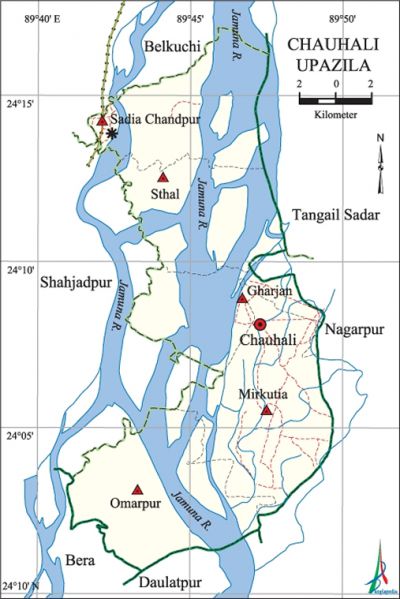Chauhali Upazila
Chauhali Upazila (sirajganj district) area 243.67 sq km, located in between 24°01' and 24°17' north latitudes and in between 89°41' and 89°59' east longitudes. It is bounded by belkuchi upazila on the north, bera and daulatpur (manikganj) upazilas on the south, tangail sadar and nagarpur upazilas on the east, Shahjadpur' and Bera' upazilas on the west.
Population Total 155260; male 81507, female 73753; Muslim 153036, Hindu 2194, Buddhist 23 and others 7.
Water bodies Main river: jamuna.
Administration Chauhali Thana was turned into an upazila in 1984.
| Upazila | ||||||||
| Municipality | Union | Mouza | Village | Population | Density (per sq km) | Literacy rate (%) | ||
| Urban | Rural | Urban | Rural | |||||
|
- |
5 |
152 |
110 |
21234 |
134026 |
637 |
47.2 |
36.6 |
| Upazila Town | ||||||||
|
Area |
Mouza |
Population |
Density |
Literacy rate (%) | ||||
|
19.14 |
2 |
21234 |
590 |
47.15 | ||||
| Union | ||||
| Name of union and GO code | Area (acre) | Population | Literacy rate (%) | |
| Male | Female | |||
|
Omarpur 37 |
14763 |
14817 |
13671 |
30.72 |
|
Gharjan 23 |
7398 |
8512 |
7592 |
33.07 |
|
Mirkutia 30 |
12033 |
29556 |
27576 |
34.05 |
|
Sadia Chandpur 47 |
12790 |
18776 |
16238 |
49.24 |
|
Sthal 71 |
10341 |
9846 |
8676 |
36.96 |
Source Bangladesh Population Census 2001, Bangladesh Bureau of Statistics.

History of the War of Liberation During the war of liberation in 1971 the Pak army, in collaboration with the local rajakars, conducted heavy plundering and set many houses on fire after establishing military camps at Malipara on 22 June and at Sambhudia in the mid August. The freedom fighters attacked the Sambhudia Pak military camp on 19 November and captured two fire arms. On 27 November, the freedom fighters again attacked the Sambhudia camp causing considerable damages to the camp; in this attack 5 freedom fighters were wounded. Chauhali upazila was liberated on 29 November.
Religious institutions Mosque 257, temple 3, tomb 1, noted of which is Tomb of Eunus Shah Enayetpuri.'
Literacy rate and educational institutions Average literacy 37.24%; Male 43.18%, female 30.7%. Educational institutions: college 5, secondary school 17, primary school 124, kindergarten 9, madrasa 15. Noted educational institutions: Enayetpur Medical College and Hospital, Chauhali Degree College (1970), Chauhalli Mahila College (1998), Betil Multilateral High School (1947), S.K High School (1965), Enayetpur High School (1946), Sambhudia Azizia Dakhil Madrasa and High School (1932), Khaskaulia K.R Pilot High School (1942), Pakrashi Primary School (1856), Enayetpur Islamia Fazil Madrasa (1889), Enayetpur Senior Madrasa (1964).'
Cultural organisations Club 53, library 6, cinema hall 1, women's welfare organisation 7, voluntary organisation 7, playground 10.
Main sources of income Agriculture 55.89%, non-agricultural labourer 2.98%, industry 10.25%,' commerce 11.76%, transport and communication 1.90%, service 6.02%, construction 0.72%, religious service' 0.23%, rent and remittance 0.22% and others 10.03%.
Ownership of agricultural land Landowner 67.61%, landless 32.39%; agricultural landowner: urban 56.83%, rural 69.26%
Main crops Peanut, garlic, onion, paddy, jute, wheat, sesame, oilseed, vegetables.
Extinct or nearly extinct crops Linseed, arahar.
Main fruits Mango, black berry, jackfruit, litchi, papaya, guava, banana.
Fisheries, dairies and poultries This upazila has a number of fisheries and poultries.
Communication facilities Pucca road km 32.01, semi-pucca road 2.9 km, mud road 178.50 km; waterways 33 nautical miles.
Extinct or nearly extinct traditional transport Palanquin.
Noted manufactories Flour mill, ice factory.
Cottage industries Goldsmith 19, blacksmith 27, potteries 7, weaving 7511, wood work 137, bamboo work, cane work 39, bidi factory 1.
Hats, bazars and fairs Hats and bazars are 14, fairs 5 most, noted of which are Enayetpur and Jotpara Hat.
Main exports Peanut, garlic.
Access to electricity All the unions of the upazila are under rural electrification net-work. However 8.51% of the dwelling households have access to electricity.
Sources of drinking water Tube-well 94.55%, tap 0.23%, pond 0.23% and others 4.99%.
Sanitation 5.87% (rural 3.20% and urban 23.28%) of dwelling households of the upazila use sanitary latrines and 90.34% (rural 93.46% and urban 70.03%) of dwelling households use non-sanitary latrines; 3.79%' of households do not have latrine facilities.
Health centres Upazila health complex 1, medical college and hospital 1, satellite clinic 3, family welfare centre 6.
Natural disasters The flood of 1988 caused heavy damages to settlements, livestock and crops of the upazila. Besides, 30 persons died of small pox in 1967.
NGO activities Operationally important NGOs are brac, CARE. [Ahmmad Ullah Kashemi]
References Bangladesh Population Census 2001, Bangladesh Bureau of Statistics; Cultural survey report of Chauhali Upazila 2007.
